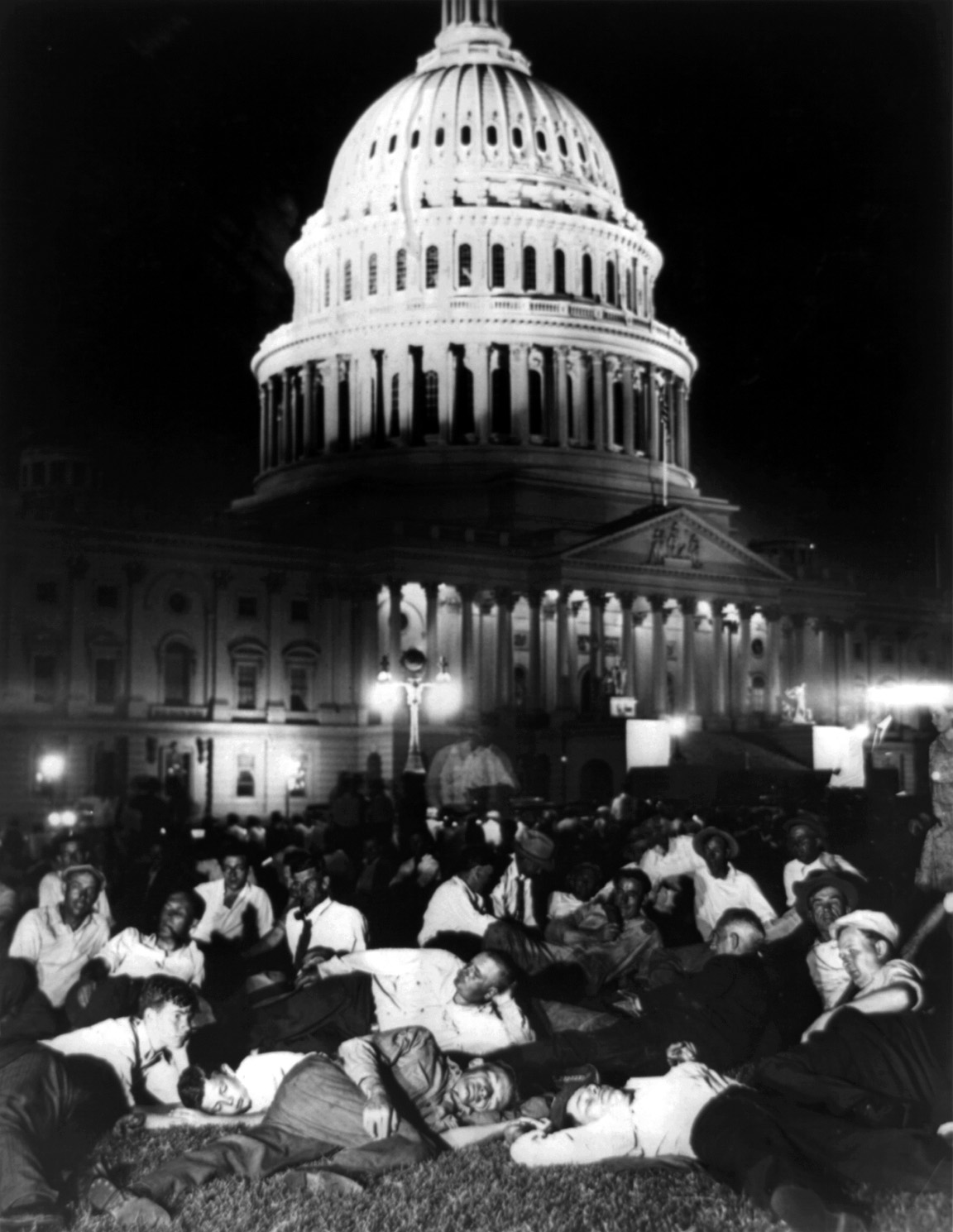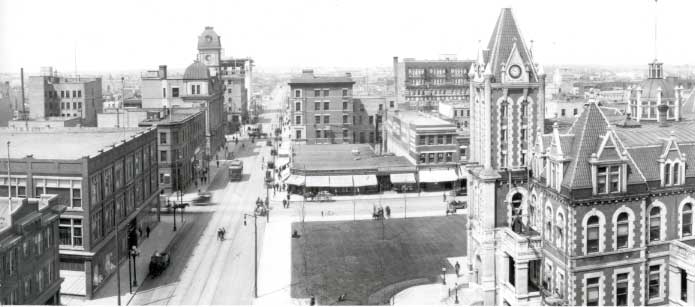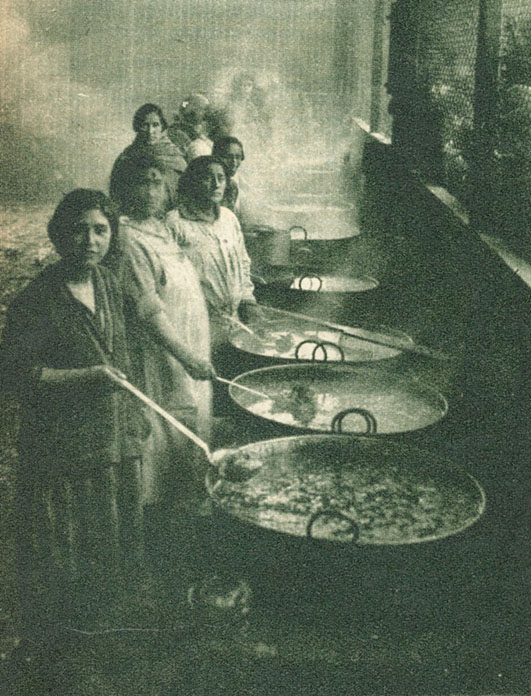|
On-to-Ottawa Trek
The On-to-Ottawa Trek was a mass protest movement in Canada in 1935 sparked by unrest among unemployed single men in federal relief camps principally in Western Canada. Federal relief camps were brought in under Prime Minister R. B. Bennett’s government as a result of the Great Depression. The Great Depression crippled the Canadian economy and left one in nine citizens on relief. The relief, however, did not come free; the Bennett government ordered the Department of National Defence to organize work camps where single unemployed men were used to construct roads and other public works at a rate of twenty cents per day. The men in the relief camps were living in poor conditions with very low wages. The men decided to unite and, in 1933, led by Arthur "Slim" Evans, created the Workers' Unity League (WUL). The Workers' Unity League helped the men organize the Relief Camp Workers' Union. A strike was held in December 1934 with the men leaving the various camps and protesting in ... [...More Info...] [...Related Items...] OR: [Wikipedia] [Google] [Baidu] |
Kamloops On To Ottawa
Kamloops ( ) is a city in south-central British Columbia, Canada, at the confluence of the South flowing North Thompson River and the West flowing Thompson River, east of Kamloops Lake. It is located in the Thompson-Nicola Regional District, whose district offices are based here. The surrounding region is sometimes referred to as the Thompson Country. The city was incorporated in 1893 with about 500 residents. The Canadian Pacific Railroad was completed through downtown in 1886, and the Canadian National arrived in 1912, making Kamloops an important transportation hub. With a 2021 population of 97,902, it is the twelfth largest municipality in the province. The Kamloops census agglomeration is ranked 36th among census metropolitan areas and agglomerations in Canada with a 2021 population of 114,142. Kamloops is promoted as the ''Tournament Capital of Canada''. It hosts more than 100 sporting tournaments each year (hockey, baseball, curling, etc) at world-class sports fac ... [...More Info...] [...Related Items...] OR: [Wikipedia] [Google] [Baidu] |
Ottawa
Ottawa (, ; Canadian French: ) is the capital city of Canada. It is located at the confluence of the Ottawa River and the Rideau River in the southern portion of the province of Ontario. Ottawa borders Gatineau, Quebec, and forms the core of the Ottawa–Gatineau census metropolitan area (CMA) and the National Capital Region (NCR). Ottawa had a city population of 1,017,449 and a metropolitan population of 1,488,307, making it the fourth-largest city and fourth-largest metropolitan area in Canada. Ottawa is the political centre of Canada and headquarters to the federal government. The city houses numerous foreign embassies, key buildings, organizations, and institutions of Canada's government, including the Parliament of Canada, the Supreme Court, the residence of Canada's viceroy, and Office of the Prime Minister. Founded in 1826 as Bytown, and incorporated as Ottawa in 1855, its original boundaries were expanded through numerous annexations and were ultimately ... [...More Info...] [...Related Items...] OR: [Wikipedia] [Google] [Baidu] |
List Of Riots And Civil Unrest In Calgary
This is a timeline of the history of Calgary. 18th century *1787 – Cartographer David Thompson spent the winter with a band of Peigan encamped along the Bow River. He was the first recorded European to visit the area. 19th century *1870 – The future site of Calgary becomes part of Canada and of the North-West Territories. *1873 – John Glenn was the first documented European settler in the Calgary area. *1875 – Originally named Fort Brisebois, after NWMP officer Éphrem-A. Brisebois, it was renamed Fort Calgary by Colonel James Macleod. *1877 – Treaty 7 is signed, and title to the Fort Calgary area is ceded to the Crown. *1882 - First sawmill on the Bow River *1883 – The Canadian Pacific Railway reached the area and a rail station was constructed. *1884 – Calgary was officially incorporated as a town and elected its first mayor, George Murdoch. *1885 – Calgary Police Service established. *1886 – The Calgary Fire of 1886. *1888 – Anglican Diocese of Calgary ... [...More Info...] [...Related Items...] OR: [Wikipedia] [Google] [Baidu] |
Estevan Riot
The Estevan riot, also known as the Black Tuesday Riot, was a confrontation between the Royal Canadian Mounted Police and striking coal miners from nearby Bienfait, Saskatchewan which took place in Estevan, Saskatchewan on September 29, 1931. The miners had been on strike since September 7, 1931 hoping to improve their wages and working conditions. Background The region's mining work was seasonal; during the rest of the year, between April and August, miners would work in the fields to supplement wages before they returned to the mines. However, the droughts in the prairies and the overall economic situation in Canada made that impossible. That led to an increasing number of men looking for work in the mines, which let mining companies to choose their workers. Furthermore, according to the Royal Commission that investigated the strike, Saskatchewan miners made half as much as their counterparts in Alberta and in British Columbia. Most of the miners and their families lived wi ... [...More Info...] [...Related Items...] OR: [Wikipedia] [Google] [Baidu] |
Bonus Army
The Bonus Army was a group of 43,000 demonstrators – 17,000 veterans of U.S. involvement in World War I, their families, and affiliated groups – who gathered in Washington, D.C., in mid-1932 to demand early cash redemption of their service bonus certificates. Organizers called the demonstrators the Bonus Expeditionary Force (B.E.F.), to echo the name of World War I's American Expeditionary Forces, while the media referred to them as the "Bonus Army" or "Bonus Marchers". The demonstrators were led by Walter W. Waters, a former sergeant. Many of the war veterans had been out of work since the beginning of the Great Depression. The World War Adjusted Compensation Act of 1924 had awarded them bonuses in the form of certificates they could not redeem until 1945. Each certificate, issued to a qualified veteran soldier, bore a face value equal to the soldier's promised payment with compound interest. The principal demand of the Bonus Army was the immediate cash payment of their c ... [...More Info...] [...Related Items...] OR: [Wikipedia] [Google] [Baidu] |
History Of Regina, Saskatchewan
The history of Regina, Saskatchewan, the capital of the Canadian province of Saskatchewan. Prior to the province's establishment, Regina served as the territorial headquarters of the then-North-West Territories and district headquarters of the territorial district of Assiniboia. 19th century Early settlement Regina was founded in 1882, when the Canadian Pacific Railway, then being built across western Canada, reached the site: by the time of the North-West Rebellion in 1885 the CPR had reached only Qu'Appelle (then called Troy), some to the east of what became Regina. The Dominion Lands Act encouraged homesteaders to come to the area where they could purchase of land for $10. The city was originally known as "Pile of Bones"—the English translation of the Cree place name "oskana kâ-asastêki" (lit. ''"Bones, which are piled"'')—because of the large amounts of buffalo bones on the banks of the Wascana Creek, a spring runoff channel rising some couple of kilometres to th ... [...More Info...] [...Related Items...] OR: [Wikipedia] [Google] [Baidu] |
Cities In The Great Depression
Throughout the industrial world, cities were hit hard during the Great Depression, beginning in 1929 and lasting through most of the 1930s. Worst hit were port cities (as world trade fell) and cities that depended on heavy industry, such as the steel and automotive industries. Service-oriented cities were hurt less severely. Political centers such as Canada, Texas, Washington, London and Berlin flourished during the Great Depression, as the expanded role of government added many new jobs. British Commonwealth and Empire Great Britain Although the impact of the Great Depression on Great Britain was less severe than elsewhere, the industrial cities of the Midlands, the North, and Scotland were very hard-hit. Liverpool and Manchester, with years of high unemployment, had already acquired a reputation as highly depressed areas. City leaders fought back, and promoted a series of reforms and innovations in infrastructure that made them leaders in urban redevelopment. Such projects i ... [...More Info...] [...Related Items...] OR: [Wikipedia] [Google] [Baidu] |
Canada In The World Wars And Interwar Years
During the World Wars and Interwar Years,1914–1947, Canada experienced economic gain, more freedom for women, and new technological advancements. There were severe political tensions over issues of war and ethnicity, and heavy military casualties. The Great Depression hit Canada hard, especially in export-oriented mining and farming communities, and in urban factory districts. World War I The July Crisis was a series of interrelated diplomatic and military escalations among the major powers of Europe in the summer of 1914, which led to the unexpected outbreak of World War I (1914–1918). At the time, Canadians were more concerned with events within their own country than European affairs. The summer of 1914 brought a second year of drought turning wheat fields into parched deserts while the two new transcontinental railways the Grand Trunk Pacific and the Canadian Northern fell further into debt, sending the thousands of men who had helped build them into unemployment. C ... [...More Info...] [...Related Items...] OR: [Wikipedia] [Google] [Baidu] |
1935 Canadian Federal Election
The 1935 Canadian federal election was held on October 14, 1935, to elect members of the House of Commons of Canada of the 18th Parliament of Canada. The Liberal Party of William Lyon Mackenzie King won a majority government, defeating Prime Minister R. B. Bennett's Conservatives. The central issue was the economy, which was still in the depths of the Great Depression. In office since the 1930 election, Bennett had sought to stimulate the economy during his first few years through a policy of high tariffs and trade within the British Empire. In the last months of his time in office, he reversed his position, copying the popular New Deal of Franklin Roosevelt in the United States. Upset about high unemployment and inaction by the federal government, voters were unwilling to allow the Conservatives to continue to govern, despite their change of policy. The Conservatives were also suffering severe internal divisions. During his first years in office, Bennett had alienated those ... [...More Info...] [...Related Items...] OR: [Wikipedia] [Google] [Baidu] |
Hugh Guthrie
Hugh Guthrie, (13 August 1866 – 3 November 1939) was a Canadian lawyer and politician who served as a minister in the governments of Sir Robert Borden, Arthur Meighen and R. B. Bennett. Biography He was born in Guelph, Ontario, the son of Donald Guthrie, and studied there and at Osgoode Hall, becoming a barrister. Guthrie was named a King's Counsel in 1902. He married Maude Henrietta, the daughter of Guelph businessman Thomas H. Scarff. Guthrie was first elected to the House of Commons as a Liberal in 1900 from the riding of Wellington South. He sat in Wilfrid Laurier's caucus for 17 years, but crossed the floor to join the Unionist government of Robert Borden as a result of the Conscription Crisis of 1917. The former Liberal backbencher became a leading light in his new party, serving as solicitor general under Borden. With the end of World War I, most Liberal-Unionists either rejoined the Liberal Party or joined the new Progressive Party. Guthrie, however, s ... [...More Info...] [...Related Items...] OR: [Wikipedia] [Google] [Baidu] |
Prime Minister Of Canada
The prime minister of Canada (french: premier ministre du Canada, link=no) is the head of government of Canada. Under the Westminster system, the prime minister governs with the Confidence and supply, confidence of a majority the elected House of Commons of Canada, House of Commons; as such, the prime minister typically sits as a Member of Parliament (Canada), member of Parliament (MP) and leads the largest party or a coalition of parties. As List of current Canadian first ministers, first minister, the prime minister selects ministers to form the Cabinet of Canada, Cabinet, and serves as its chair. Constitutionally, Government of Canada#Crown, the Crown exercises Executive (government), executive power on the Advice (constitutional law), advice of the Cabinet, which is collectively Responsible government, responsible to the House of Commons. Justin Trudeau is the List of prime ministers of Canada, 23rd and current prime minister of Canada. He took office on November 4, 2015 ... [...More Info...] [...Related Items...] OR: [Wikipedia] [Google] [Baidu] |
James Garfield Gardiner
James Garfield Gardiner (30 November 1883 – 12 January 1962) was a Canadian farmer, educator, and politician. He served as the fourth premier of Saskatchewan, and as a minister in the Canadian Cabinet. Political career Gardiner was first elected to the Legislative Assembly of Saskatchewan in 1914, served as Minister of Highways (1922–1926) in the government of Premier Charles A. Dunning from 1922, and succeeded Dunning as premier in 1926. A highly-partisan Liberal, his government lost its majority in the legislature in the 1929 election both from patronage scandals and partly through an anti-French, anti- Catholic and anti-immigrant campaign waged by the Ku Klux Klan. Although the Conservative Party had won fewer seats, it was able to defeat the Gardiner government through a motion of no confidence and then formed a "co-operative government" with the support of some Progressive Party and independent Members of the Legislative Assembly. As Leader of the Opposition, ... [...More Info...] [...Related Items...] OR: [Wikipedia] [Google] [Baidu] |









.jpg)